High Voltage Test
WHAT IS A HIGH - VOLTAGE TEST?
An electrical high-voltage test (HV test), also known as a high-voltage insulation test or dielectric strength test, is a procedure for testing the insulation strength of electrical devices or systems. A high voltage is applied to ensure that the insulation of the device or system meets the required safety standards. The test is carried out to identify possible insulation faults or weaknesses that could lead to electric shock or other hazards. The high voltage test is usually performed with specialised test equipment that can generate a high voltage while limiting the current flow to prevent damage to the equipment under test.
HOW IS A HIGH-VOLTAGE TEST CARRIED OUT?
Here are the basic steps to perform a high-voltage test:
- Preparation: Make sure that the device is switched off and disconnected from the power supply. Also check that the tester is working properly and is calibrated.
- Connecting the test device: Connect the tester to the device connections to be tested. Ensure that the connection is firm and secure.
- Setting the test voltage: Set the desired test voltage on the tester. The test voltage depends on the specific requirements of the device or the standard according to which the test is performed.
- Performing the test: Switch on the tester and start the high-voltage test. The tester generates a high voltage which is applied to the device or component. The test duration may vary depending on the requirements.
- Evaluation of the result: During the test, it is monitored whether a breakdown or an impermissible current flow occurs. If a breakdown or an impermissible current flow is detected, the test is deemed to have failed. If no breakdown or impermissible current flow occurs and the insulation strength of the device or component is maintained, the test is deemed to have been passed.
The safety guidelines in accordance with EN 50191 must be observed throughout the entire process. It is important that the test is carried out by trained personnel, as high voltages are used and this can lead to dangerous situations. In addition, the cables or devices to be tested should be de-energised before the test in order to avoid accidents.
-
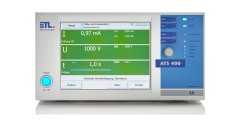 ATS400 UH-50Article number 202036
ATS400 UH-50Article number 202036- HV AC - High Voltage Testing
100,0 - 5000 V AC, 0,01 - 100,00 mA (opt. from 1 nA), potential free, ramp, discharge monitoring - Contacting options
CC
- HV AC - High Voltage Testing
-
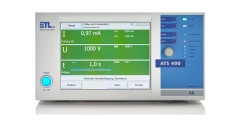 ATS400 UH-50LArticle number 207093
ATS400 UH-50LArticle number 207093- HV AC - High Voltage Testing
100,0 - 5000 V AC, 0,01 - 2,50 mA (opt. from 1 nA), current limited, potential free, ramp, discharge monitoring - Contacting options
CC
- HV AC - High Voltage Testing
-
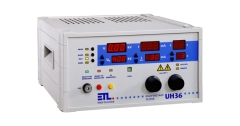 Hi Pot Tester UH36 - 5 kV AC / 100 mA / 500 VAArticle number 200208
Hi Pot Tester UH36 - 5 kV AC / 100 mA / 500 VAArticle number 200208- HV AC - High Voltage Testing
100,0 - 5000 V AC, 0,50 - 100 mA , potential free, ramp, discharge monitoring
- HV AC - High Voltage Testing
-
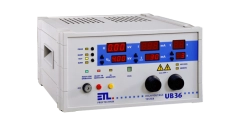 Hi Pot Tester UB36 - 5kV AC / 2,5 mA / current-limitedArticle number 201788
Hi Pot Tester UB36 - 5kV AC / 2,5 mA / current-limitedArticle number 201788- HV AC - High Voltage Testing
100,0 - 5000 V AC, 0,5 - 2,5 mA, current limited, potential free, ramp, discharge monitoring
- HV AC - High Voltage Testing
-
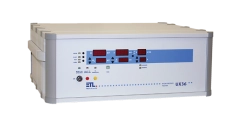 Hi Pot Tester UX36 - 5 kV AC / 200 mA / 1000 VA with dry transformerArticle number 202194
Hi Pot Tester UX36 - 5 kV AC / 200 mA / 1000 VA with dry transformerArticle number 202194- HV AC - High Voltage Testing
100,0 - 5000 V AC, 0,50 - 200 mA, potential free, ramp
- HV AC - High Voltage Testing
-
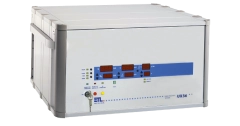 Hi Pot Tester UX36 - 5 kV AC / 500 mA / 2500 VA with dry transformerArticle number 204114
Hi Pot Tester UX36 - 5 kV AC / 500 mA / 2500 VA with dry transformerArticle number 204114- HV AC - High Voltage Testing
100,0 - 5000 V AC, 1,00 - 500 mA, potential free, ramp
- HV AC - High Voltage Testing
-
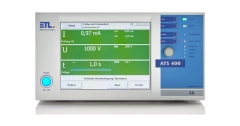 ATS400 UHIR-5030LArticle number 211375
ATS400 UHIR-5030LArticle number 211375- HV AC - High Voltage Testing
100,0 - 5000 V AC, 0,01 - 100,00 mA, potential free, ramp, discharge monitoring - ISO - Insulation Testing
50,0 - 3000 V DC, 500,0 kΩ - 1000 MΩ (opt. 5 GΩ), current limited accor. EN 50191, earthed on one side, active discharge, ramp, discharge monitoring - R - Resistance Measurement DC4
1 µA - 2 A, 0,01 µΩ - 2,2000 MΩ, 4-wire measuring technique, contact monitoring, automatic measuring range selection, optional 11 fixed measuring ranges - Contacting options
CCC
- HV AC - High Voltage Testing

